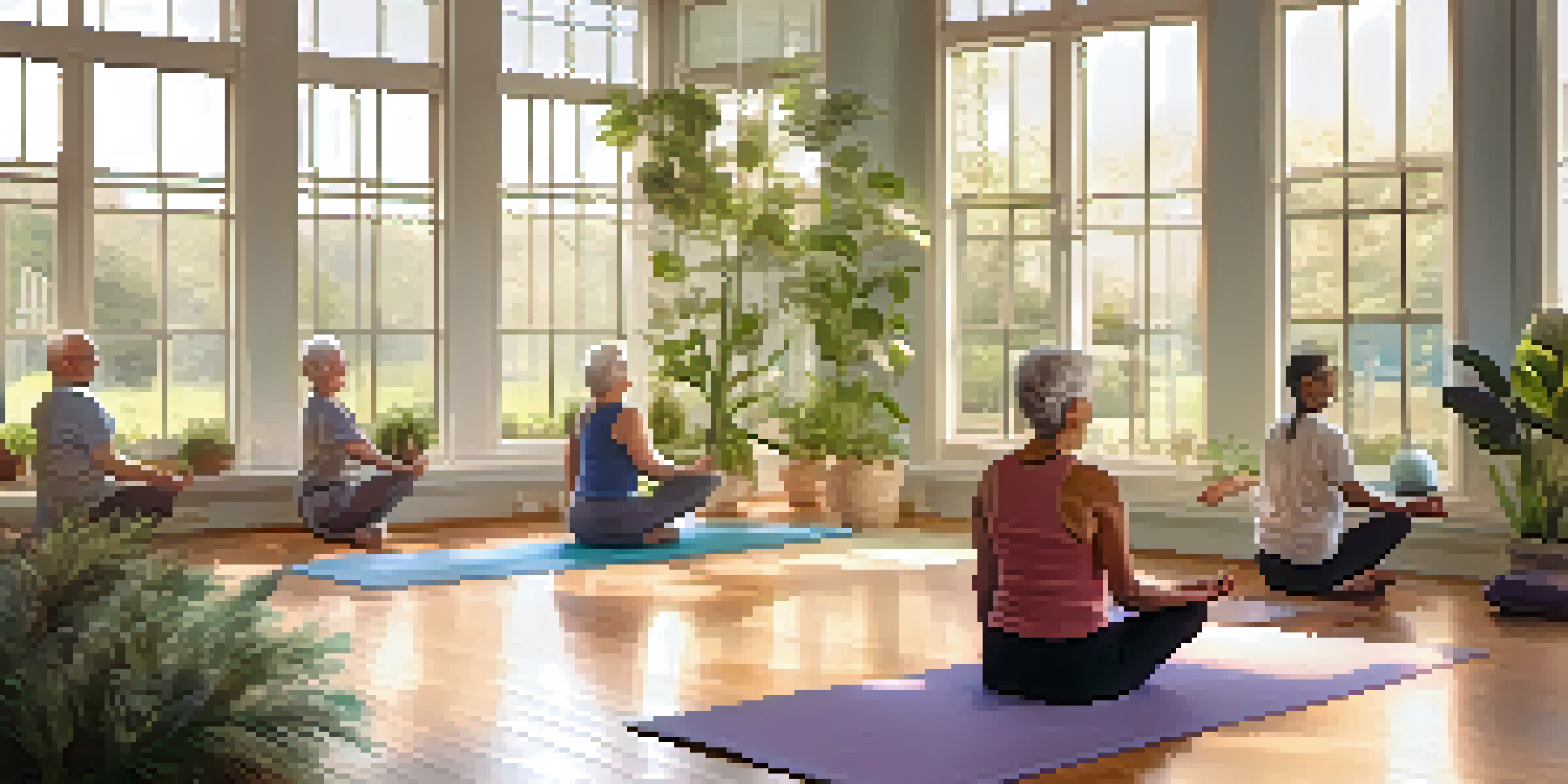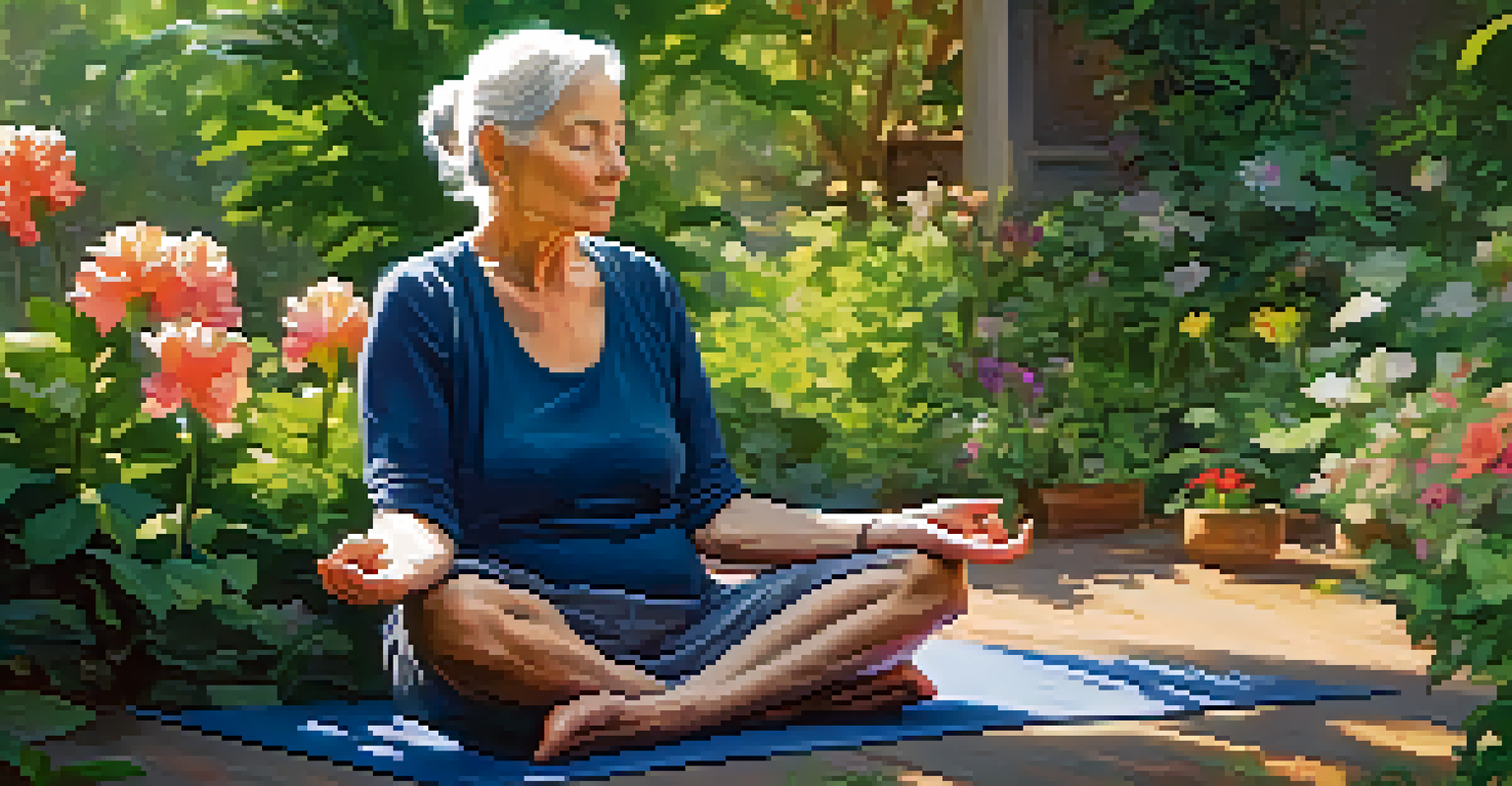Mindfulness in Gentle Yoga: A Guide for Senior Practitioners

Understanding Mindfulness and Its Benefits for Seniors
Mindfulness is the practice of being fully present in the moment, and it can be particularly beneficial for seniors. It encourages a deeper awareness of body sensations, thoughts, and emotions, fostering a sense of peace and acceptance. By incorporating mindfulness into yoga, seniors can enhance their overall well-being and improve their quality of life.
Mindfulness isn't difficult, we just need to remember to do it.
Engaging in mindfulness helps reduce stress and anxiety, which can often be heightened in later years. When seniors practice being mindful, they cultivate a positive mindset and can better manage daily challenges. This mental clarity can lead to improved emotional health and resilience.
Moreover, mindfulness can enhance the physical practice of yoga itself. By focusing on the breath and movements, seniors can develop a better understanding of their bodies, which may help prevent injuries and promote safer, more effective practice.
The Role of Gentle Yoga in Enhancing Mindfulness
Gentle yoga is a perfect complement to mindfulness, especially for those in their senior years. This style of yoga is designed to be accessible and accommodating, making it easier for seniors to connect with their bodies and breath. The slow, deliberate movements allow for a deeper exploration of physical sensations, promoting mindfulness.

In gentle yoga, practitioners often focus on simple poses that emphasize flexibility, balance, and relaxation. These gentle movements provide an opportunity to practice being present while cultivating a mind-body connection. This connection is not only vital for physical health but also nurtures a sense of peace and grounding.
Mindfulness Benefits Seniors' Well-Being
Practicing mindfulness helps seniors reduce stress and improve emotional health, enhancing their overall quality of life.
Additionally, gentle yoga encourages mindfulness through its emphasis on breath work. As seniors learn to synchronize their breath with movement, they become more attuned to their internal states, fostering a calming and centered experience.
Key Mindfulness Techniques for Gentle Yoga Practice
Incorporating mindfulness techniques into gentle yoga can transform the experience for senior practitioners. One effective method is focusing on the breath, allowing each inhalation and exhalation to anchor attention in the present moment. This simple practice can help quiet the mind and deepen the yoga experience.
Yoga is the journey of the self, through the self, to the self.
Another technique is body scanning, where practitioners mentally check in with different body parts, noticing any tension or discomfort. This awareness helps seniors understand their physical limitations and encourages gentle adjustments in their practice. It’s an empowering way to cultivate self-compassion and patience.
Finally, using visualization can enhance mindfulness during yoga. Seniors can imagine peaceful scenes or positive affirmations while holding poses, creating a serene mental space that fosters relaxation and joy. This approach not only uplifts the spirit but also reinforces the mind-body connection.
Creating a Mindful Environment for Yoga Practice
The environment in which one practices yoga can greatly impact the mindfulness experience. For seniors, creating a calming space filled with soft lighting, comfortable mats, and soothing sounds can help facilitate relaxation. It's essential to choose a place that feels safe and inviting, allowing for a deeper focus on the practice.
Incorporating elements like essential oils or gentle music can further enhance the atmosphere. Aromatherapy, for instance, can evoke feelings of tranquility and promote a sense of well-being. These sensory enhancements help seniors feel more connected to their practice and encourage a mindful state.
Gentle Yoga Enhances Mindfulness Practice
Gentle yoga is accessible for seniors and promotes mindfulness through slow movements and breath synchronization.
Lastly, minimizing distractions is crucial for fostering mindfulness. Seniors should aim to practice in a quiet space where they are free from interruptions, allowing them to immerse themselves fully in the experience. This intentional environment supports a more profound engagement with both yoga and mindfulness.
Finding the Right Gentle Yoga Class for Seniors
Choosing the right yoga class can make all the difference for senior practitioners seeking mindfulness through gentle yoga. Look for classes specifically tailored for seniors, as these often take into account the unique needs and limitations of older bodies. Instructors trained in gentle yoga can provide modifications and support.
It’s important to find a class that emphasizes mindfulness and relaxation, rather than a fast-paced or competitive atmosphere. Many studios offer classes labeled as 'gentle' or 'restorative,' which prioritize a slower pace and focus on breath and alignment. These environments are often more conducive to mindfulness.
Additionally, consider the instructor's approach and philosophy. A good instructor will encourage participants to listen to their bodies and honor their limits, fostering an environment of acceptance and mindfulness. This supportive atmosphere can greatly enhance the yoga experience for seniors.
Combining Mindfulness with Daily Life for Seniors
Mindfulness isn’t limited to the yoga mat; it can be integrated into everyday life for seniors. Simple practices like mindful eating, where one focuses on the flavors and textures of food, can enhance appreciation for meals and promote healthier eating habits. This awareness can transform routine activities into opportunities for mindfulness.
Moreover, seniors can practice mindfulness during walks or other physical activities by paying close attention to their surroundings and sensations. For example, noticing the feel of the ground beneath their feet or the sounds of nature can enrich these experiences and keep them grounded in the present.
Creating a Calming Yoga Environment
A tranquil practice space with minimal distractions enhances mindfulness and allows seniors to fully engage in their yoga experience.
By making mindfulness a daily practice, seniors can cultivate a greater sense of joy and contentment. This holistic approach not only enhances their yoga practice but also contributes to a more fulfilling and balanced life.
Overcoming Challenges in Practicing Mindfulness and Yoga
While practicing mindfulness in gentle yoga can be rewarding, seniors may face challenges along the way. Common hurdles include physical limitations, distractions, or even a wandering mind during practice. Recognizing these obstacles is the first step in finding solutions.
It’s essential to approach these challenges with patience and compassion. Seniors should remember that it’s perfectly normal for the mind to wander; the key is to gently guide it back to the breath or body sensations without judgment. This practice of self-compassion is, in itself, a form of mindfulness.

Additionally, seeking support from a community can greatly enhance the experience. Joining a group or class can provide encouragement and motivation, making it easier to overcome challenges together. Sharing experiences with fellow practitioners can foster a sense of belonging and connection, further enriching the mindfulness journey.